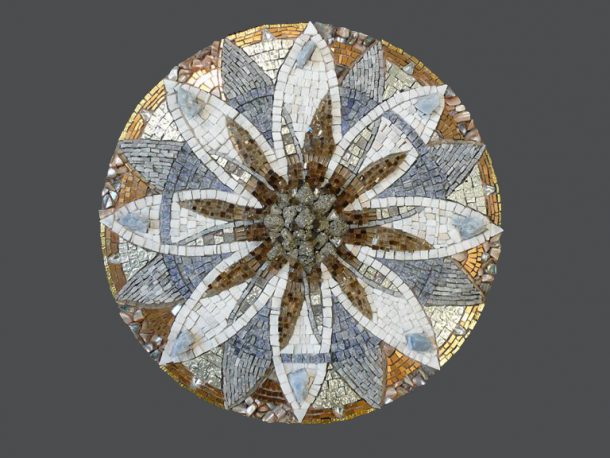
Toyoharu Kii, “Short Stories” Bibliomosaico exhibition, Ravenna Mosaico, 2011
In mosaic circles, we speak about a mosaic ‘grammar’ or the language of mosaic. We’re usually referring to the various ancient setting patterns used to express a mood within the matrix of a mosaic. This rhythmic pattern, known as OPUS in Latin, or work, is traditionally expressed using cut stone and glass. In plural, these would be ‘OPERA’. (Well, not like Pavarotti singing ‘La Traviata’, but almost). Some common forms include Opus Regulatum, a grid-like setting pattern, or Opus Vermiculatum, which comes from the Latin term for “worm” and refers to a wavy, winding setting pattern. There are many more. We mosaicists like to talk a lot about how a mosaic surface is worked!
Recently, I’ve noticed there’s a contemporary art trend of using words or letters— language— as the mosaic itself. A ‘double entendre’ if you will. Entendre is French for “to hear”, So double entendre means a phrase that can be taken in more than one way… And there you have the irony of meaning. Do we hear or see mosaics?
Music, Muse, Mosaic, Museum…all derive from the same Greek root word, μουσική for music, a divine order…and mosaics are called l’arte musivum, the Art of the Muses.
Class dismissed. But not before you have look at these:

Georgiadi Thessalonikeos Despina, “e-book”, 2011 at the Old Franciscan Cloisters, Ravenna Mosaico exhibition “Mosaic Installations”

QWERTY 5, an installation by Sarah Frost, at New York’s James Hotel, 2010

Detail of QWERTY 5, by Sarah Frost, 2010
Frost’s pieces, made entirely out of cast-off keyboard keys, discarded by an array of users from individuals and small businesses to financial institutions, government offices and Fortune 500 companies, can cover whole rooms. Each key has a unique history and bears the imprint of the thousands of taps by countless users.
See more of Sarah Frost’s work here.

Samantha Holmes, “Unspoken, 10.22.10 – 07.07.11” – detail
Above, Samantha Holmes recently won a 2000 Euro prize for this piece for the Use of Unconventional Technique and Materials. Seen at the GAEM exhibition at Ravenna Mosaico 2011, this old wooden sample board normally used for mosaic samples of colored glass instead contains folded and bound papers bearing her private thoughts. Read an excellent recount of this work and the backstory from the artist on MosaicArt Now.
In the video below, Raniero Bittante’s multi-media mosaic-riff seen at the BIBLIOMOSAICO exhibition in Ravenna. The exhibition, conceived by Rosetta Berardi invited many mosaic artists to create mosaic ‘books’. Using three copies of the Repubblica Italiana, Italy’s constitution, each book is embellished with red, white and green smalti (colors of the Italian flag) and representing the fragmentation of unity – the wads of chewed bubble gum, the cohesion. The “mosaic work” was enhanced by a tiny video screening of citizens blowing bubbles – then the gum was used to stick the pieces (tesserae, in Italian) to the book. A tribute and reflection on Italy’s 150th year.
[wpvideo 98bASysk]
“It’s an experimental blending of contemporary mosaic and the hand-written essay of the tedious variety that school children dread.”

Jo Braun, “Three Page Essay”, 2011 “Works of the World” exhibit Ravenna Mosaico

I saw this at KokoMosaico studio in Ravenna: a book filled with peering mosaic eyes. By Filippo Bandini for Bibliomosaico 2009 edition

Could this be any more adorable?


Another great post. I really appreciate the way you pull together mosaics around a theme. I’ll be adding to Twitter’s #MosaicMonday. Thanks for the Mosaic Art NOW mention!
Nancie, you betcha! thanks for tweeting it up. I always look to MosaicARt NOW and your coverage of the GAEM show was excellent. I found your insight to Samantha Holmess journey very compelling, and that she wrote all those little pieces of paper while trying to learn the language. I can relate to when i was a young student in Italy…making art heals the heart and soul!
The unknown artist mentioned above is Arianna Gallo. http://www.kokomosaico.com/chi-siamo/arianna-gallo/
Thank you Christine! I met Luca while visiting but not Arianna, so glad to be able to properly attribute the work. I was so happy to visit their lively mosaic workshop and classroom in Ravenna. I love your work, and congratulations on your book! So clever. thanks for reading and commenting. hope to see you here again soon.
Lucky you! And thank you. I hope to finish it in the next few months. I enjoy your blog, thanks for the great posts!
The mosaic, which have wrongly attributed to Arianna Gallo was made by Filippo Bandini for Bibliomosaico 2009 edition.
Thank you!
Rosetta Berardi
Grazie Rosetta – we are getting to the bottom of this! thank you for correction to the book with eyes by Fipippo Bandini! When I originally posted, in the caption it said: “I don’t know who did this work, do you?” As you can see, we making headway!
It’s difficult to find well-informed people on this subject, however, you seem like you know what you’re talking about! Thanks|